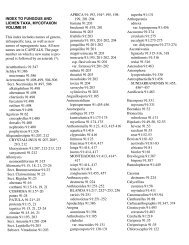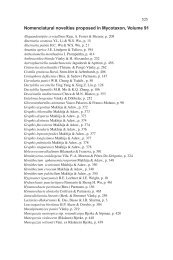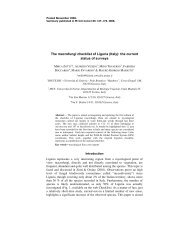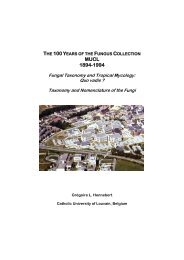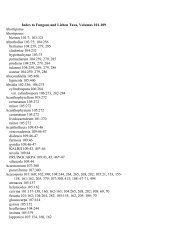download full review [pdf] - Mycotaxon
download full review [pdf] - Mycotaxon
download full review [pdf] - Mycotaxon
Create successful ePaper yourself
Turn your PDF publications into a flip-book with our unique Google optimized e-Paper software.
540 ... Hawksworth, Editor<br />
2002; see <strong>Mycotaxon</strong> 87: 500-501, 2003), he described 52 species of the 104<br />
species identified (every second one was new for science!) and even noted that<br />
47 further taxa could not be described because of insufficient material or being<br />
in poor condition. It is not surprising that the current monograph published<br />
with co-author Leopoldo García Sancho on lichenicolous fungi mainly from<br />
Chile increases the number of new taxa known from South America even<br />
further. All specialists studying lichenicolous fungi will want to have this new<br />
book with such a comprehensive amount of information in his or her bookcase<br />
as much as they wanted to have his former book.<br />
An international group of lichenologists from Spain and Denmark undertook<br />
two expeditions (in 2005 and 2008) to southern Chile and Argentina. They<br />
explored 60 localities, most of them in the Isla Navarino in the Beagle Channel.<br />
The present study of lichenicolous fungi is based on 696 samples representing<br />
240 species, of which 189 are published in this book and of which six genera<br />
and 60 species are described as a new to science. Still, a further 51 species<br />
remain as undescribed!<br />
In 1999, Galloway & Quilhot (Gayana Botanica 55: 111-185, 1999<br />
[“1998”]) published a checklist of Chilean lichen-forming and lichenicolous<br />
fungi in which they reported only 32 lichenicolous fungi, based mainly on the<br />
collections of Spegazzini, Dodge, and Wedin.<br />
The new species are described in detail and are well documented by 123 (of<br />
132) excellent drawings and photographs, which we have come to expect as<br />
typical for Etayo. The introductory chapters are well written, and introduce the<br />
abiotic factors that influence the area as well as biotic factors (mainly vegetation<br />
types). Separate chapters discuss the hosts, co-evolution, and host specificity of<br />
lichenicolous fungi. A short note promises that a <strong>full</strong> account of the lichen biota<br />
of the study area will be published too.<br />
Six new genera are described: Atronectria, similar to Pronectria but with<br />
brown, K+ blackish green ascomata; Macrographa, with large ascomata and<br />
three septate spores of unknown affinities; Pseudostigmidium, related to<br />
Stigmidium, but generally with an I+ red hymenium and 3-septate spores,<br />
with five species living on Pseudocyphellaria and Nephroma; Sarcoexcipula,<br />
with a thick and complex perithecial wall and large and septate ascospores;<br />
Umbilithecium, an Arthonia-like genus but with a different hymenial structure<br />
and simples spores; and Umushamyces, similar in habit to Arthonia, but with<br />
Biatora- or Bacidia-type asci.<br />
Sixty new species are described in Arthonia, Atronectria, Bachmanniomyces,<br />
Capronia, Carbonea, Chalara, Corticifraga, Corticiruptor, Dactylospora,<br />
Diederimyces, Endococcus, Leptosphaeria, Lichenochora, Lichenopeltella,<br />
Macrographa, Merismatium, Microsphaeropsis, Minutoexcipula, Muellerella,<br />
Nanostictis, Nectriopsis, Neobarya, Niesslia, Odontotrema, Phaeosporobolus,


![download full review [pdf] - Mycotaxon](https://img.yumpu.com/5381692/32/500x640/download-full-review-pdf-mycotaxon.jpg)
